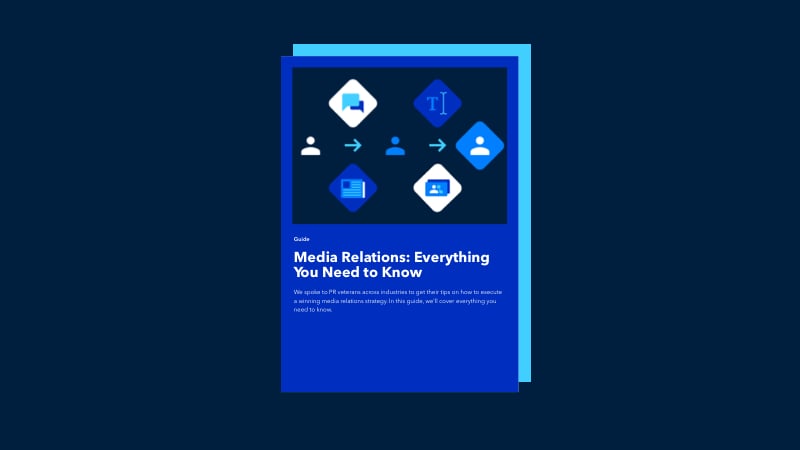The million-dollar question: how the heck do I measure and report the results of a communications campaign to my boss? And what should be in the report? Media value? Brand awareness? Engagement?
There are quite a few articles out there about how you should write goals and measure your PR strategy. We feel that many of these are quite subjective because they’re promoting their software. Many are just plain wrong. We don’t sell software to measure your PR efforts, but we do work with over 300 communications teams. Here’s our honest take on measuring PR.
Setting PR goals and measuring results
First of all, we think it would be a bit silly for us to decide how you should measure your PR efforts’ success. Success is entirely dependent on the role PR plays in your communications strategy. It’s dependent on the goals you set. You can generate thousands of visitors to your website, but that isn’t worth much if your objective is generating sales, and none of the visitors buy anything.
Before we move on to examples of how you can set and measure your PR efforts, we need to move this conversation into the geeky realm of measurement. There are too many misunderstandings about measuring marketing and PR efforts, which might hurt your company and your team’s morale. To formulate good measures and recognize the bad ones, you need to know about objectives, lag measures, and lead measures.
PR objectives, lag measures, and lead measures
There’s a book that we like to read here at pr.co: The Four Disciplines of Execution, by Sean Covey. The book has helped us understand how to formulate measures that show a team how their campaigns perform instead of killing team morale. If you’re a manager or reporting to one: we highly recommend checking it out. For now, we’ll share the most relevant learning: objectives, lead measures, and lag measures.
Lag measures track the success of your objective, your most important goal. You cannot influence lags directly. Lags are measures you spend time losing sleep over. They are things like revenue, profit, brand awareness, and customer satisfaction. They are lag measures because by the time you see them increase or decrease, that which drove the change has already passed. You can’t do anything to fix them; they are history.
Lead measures track the critical activities that drive (or lead) to the lag measure. They predict the success of the lag measure. The big difference with lag measures is that your team directly influences lead measures: they are things like new contacts, news announcements sent out, completed campaigns. It’s imperative to focus on lead measures you can directly influence. Lag measures are often easier to measure, and they represent the result we ultimately want, but without executing on lead measures, they will bear nothing but frustration.
To put it another way, let’s say, for example, you’re trying to get in shape and shed those kilos you gained during the winter. Your lag measure would be weight. Your lead measure would be exercising and eating well. You can directly influence your lead measures. So if the lag measure is losing 10 kgs, your lead measure would be eating your greens and sweating it out.
TLDR; lead measures are the buttons you can turn to make a difference; lag measures show if you turned the right buttons. Find the right buttons, and focus on those.
Here are some examples of objectives to help you get on the right track, including some suggestions of their corresponding lead measures and lag measures.
Defining a goal for your PR strategy
What role do you think media relations should play in your marketing strategy? Build awareness? Persuade people that are already tempted to buy your product? Enter new markets?
Each goal comes with its lags and leads, so pick the goal that’s important for your company: your so-called wildly important goal. Don’t get tempted and formulate loads of different goals - the key to great results is focus. Unlike Rain man, our brains have limits; the more focus you allocate to a project, the better it gets. By picking too many goals, you probably won’t achieve any of them.
Ask anyone successful in (scaling up a) business what advice they give to other teams, and 9 out of 10 will respond with focus.
PR Measurement Examples
Lag measures
When defining lag measures, your vision as a communications strategist comes in. If my goal is increasing brand awareness, how will I know I’m on the right track? Here are a few examples of lag measures in media relations strategies:
- Targeted coverage: count the number of publications. Just be mindful that the value of the same publication varies for each company. A publication can have an immense reach, but that isn’t necessarily the right reach. You could make a bucket list of magazines, blogs, newspapers, etc., you want to get published and weigh those publications differently.
- Backlinks: we spoke with an SEO expert that shared tips and advice on leveraging SEO for PR professionals—his advice for measurement: backlinks. As a PR team, you’re building a brand. You’re building authority. And online, authority is measured with backlinks. Building backlinks is hard work, and there are no shortcuts: backlinks from syndication websites that you landed by dropping a press release in a random newswire service don’t count.
- Media value: Here’s a measure many companies use, and it’s one about which we have mixed feelings. Media value calculates how much the real estate on a blog, magazine or newspaper would have cost if you bought that same amount of pixels or paper through their sales department (as an ad). Problems: media value is defined by companies like Google or sales teams at newspapers and magazines. As stated before, media value is entirely dependent on whether your audience reads the outlet that mentions your brand. A review on a super-niche blog might just be worth more than a byline in The Sun.
- Reviews: The nice thing about reviews is that they reach people that are in the ‘consideration’ or ‘selection’ phase: they’re considering a product or in the process of selecting the right brand. A good review here, especially one with a backlink, will attract a group of people that are highly likely to convert into customers. They’re positioned at the bottom of a sales funnel, but perhaps not your sales funnel, but your competitor’s. Reach this group, and you’ll see the effects on your conversion rates and bottom line.
- Quality of your pitches: Doing a lot of network building and pitching? Measure the quality of your subject line with your total open rates, measure the quality of your pitch with the click-through rates in your email (make sure you link to an online news announcement or additional material!) and the response rate.
- Leads: If a lead clicks on a link in a press mention and converts immediately or later, you should be able to see that in Google Analytics. Google Analytics has a tab named assisted conversions, where you’ll see if any of your press mentions have been a touchpoint before a visitor converted into a lead. Keep in mind: not all leads click on a link; some visit your website directly by typing in your domain or looking you up on Google. Some others aren’t tracked— it’s murky, we know.
- Visitors: Pageviews - this one’s easy to measure, right? Now, a boost in page views is excellent; it makes you feel good. But it’s not a good metric; because it’s not correlated to business success. Many of these easy-to-measure metrics make you feel good but shouldn’t be used to make decisions. They’re called vanity metrics, more on that later.
Lead Measures
Lead measures will help your team focus on the right things. Lead measures depend on the lag measures you set: again, they’re the buttons you turn to see a change in your lags.
To give you a good idea of lead measures you could work with, here are a few examples:
If you’re building or expanding a (new) network of press contacts:
- Publish x number of articles on your blog or thought-leadership platform
- Connected on social with x number of press contacts on LinkedIn & Twitter
- Shared x number of news announcements, blogs, and press mentions on LinkedIn and Twitter
- Engage with press contacts’ articles
If you have news to get published:
- Send x number of targeted pitches to your contacts.
If your goal is to build backlinks:
- Reach out to x number of (press) mentions and ask if they’re willing to add a link
- Build collateral that incentivises press contacts to link back to.
By choosing the right lag measures, your team will know how to move forward. Clarity is key.
“Once a team is clear about its lead measures, their view of the goal changes.”
Chris McChesney, co-author of The Four Disciplines of Execution
Common problems with measuring results in communication
Now there are a few problems with measuring results in communication: they’re often quite difficult to measure. A few common issues are:
- Vanity metrics
Vanity metrics are things you can measure that simply don’t matter. They’re easily changed or manipulated, and they don’t bear a direct correlation with numbers that speak to business success. Pageviews, for instance, don’t necessarily tell you that your target audience is finding your website; it could also mean that an army of strangers accidentally rolled onto your website. They’ll be leaving the page as soon as they can or burying your customer support team under the craziest requests and questions you’ve ever read.
Examples of vanity metrics are page views, impressions, likes, etc. Why would so many off-the-shelf analytics tools and reporting tools show you these vanity metrics then? Because they make their users feel good.
When selecting the right leads and lags, you should use metrics that correlate with business success.
Instead of page views, use conversion rate from visitors to trials or from visitor to sign-up.
- Isolating the effect of your PR campaign
Press campaigns almost always go live together with all kinds of different marketing campaigns. It is pretty tricky to isolate your PR campaign’s effect, specifically between all of these streams of traffic from various sources. A backlink certainly helps but doesn’t completely solve the issue. - Measuring the effect of offline press mentions
And finally, there are offline press mentions from traditional media like newspapers, radio, print magazines. You will not find these back in your online analytics - you might find an indication of success, for instance, when you see a significant traffic spike or spike in conversions around a radio interview, but it won’t be iron-clad.
Conclusion
- Only measure what matters: Focus on your most important objective, and formulate lag measures and lead measures based on that objective. There is much, much, much more you could measure, but if you’re not using the data, it’s nothing but a distraction.
- Behind every number is a person: It’s easy to forget that behind those numbers, there are people. Statistics are just a way to measure and analyze the opinions and behavior of large groups of people. Seeing something interesting in your data and not sure what it means? Pick up the phone, or send an email and call your customers/leads/press contacts; you’d be surprised by how much you’ll learn.
- Don’t get distracted with vanity metrics: Only use measures that correlate with your business success. It might require some manual work to measure them, that’s normal. Many off-the-shelf analytics platforms provide you with metrics that make you feel great but don’t help you make good decisions.
Sjors Mahler is the Commercial Director at pr.co. He’s worked with PR and communications teams for 9 years and has organized dozens of meetups and events for the Amsterdam PR community. Sjors has an MSc in Persuasive Communications and specializes in branding, sales strategy, and inbound PR.. Connect on LinkedIn or send an email






